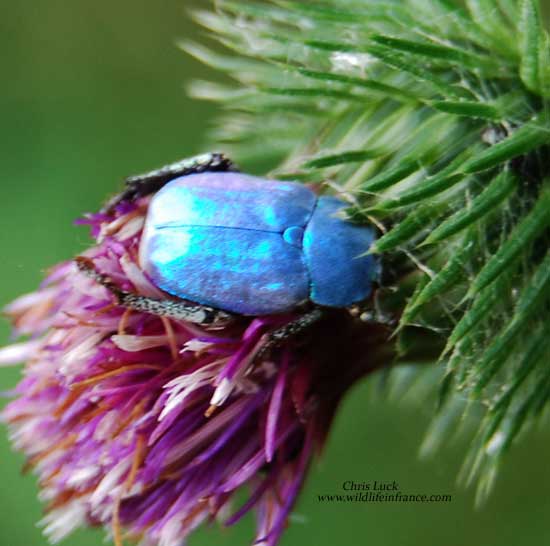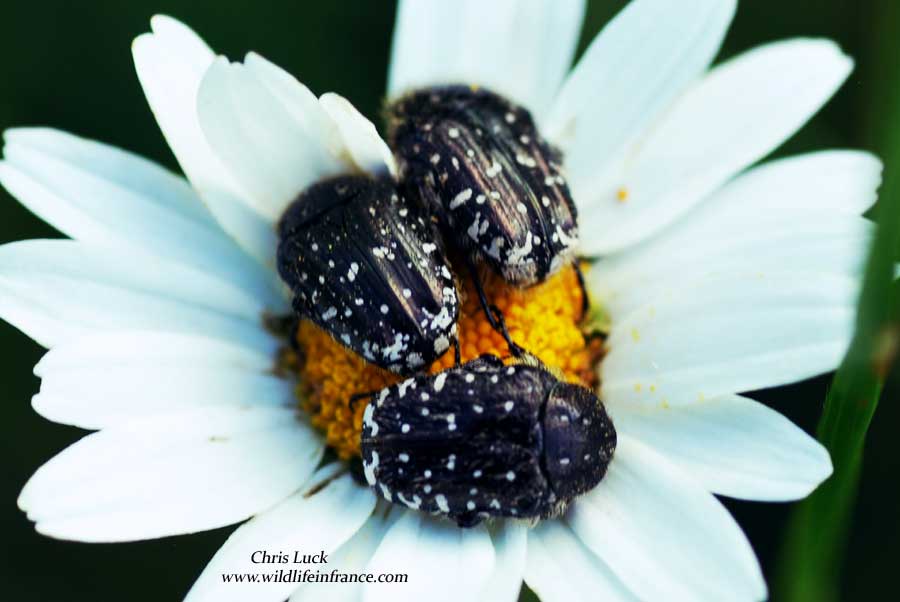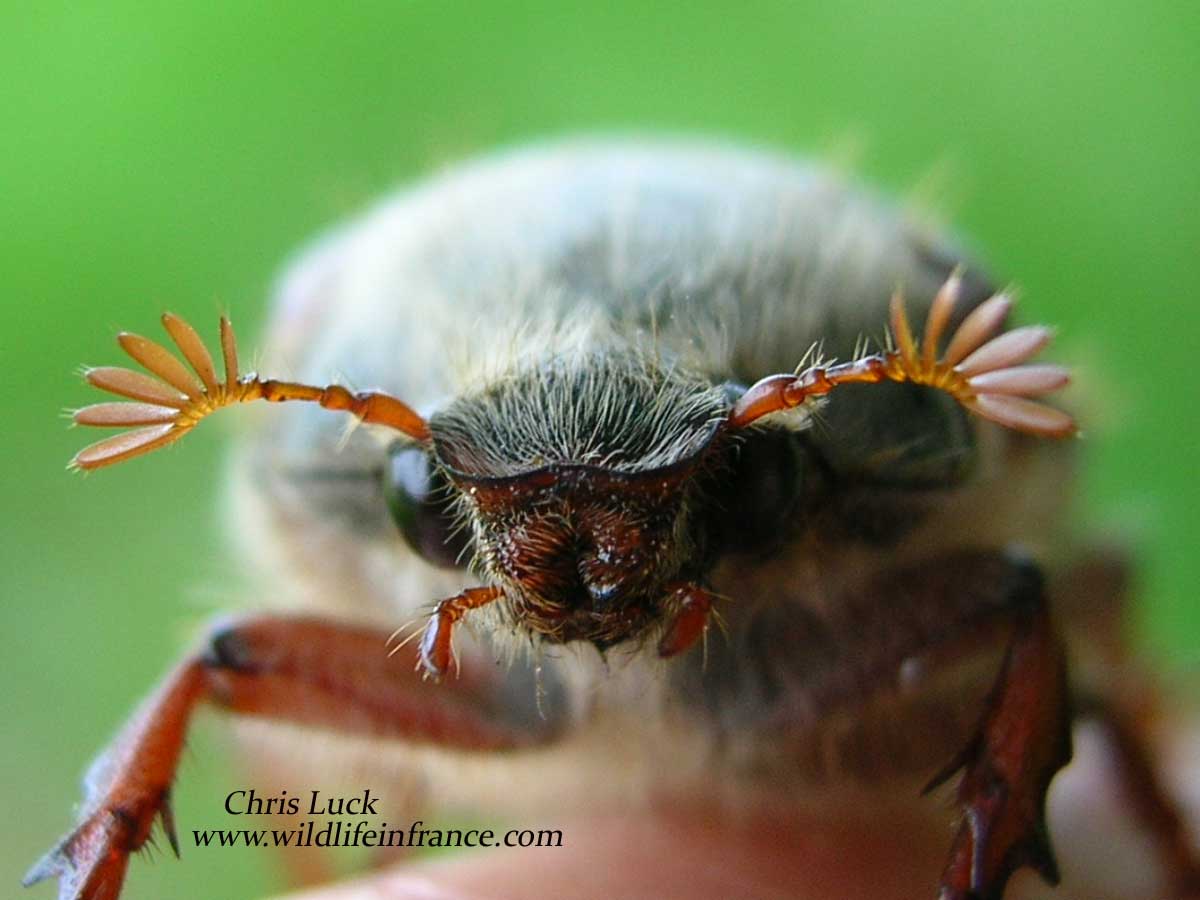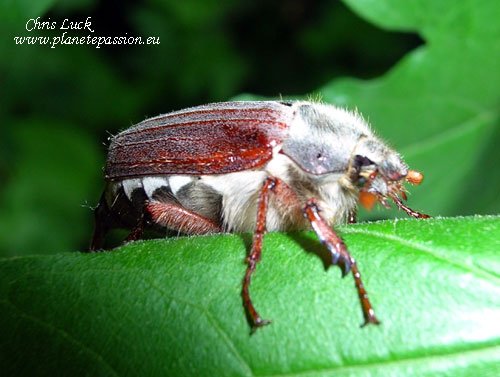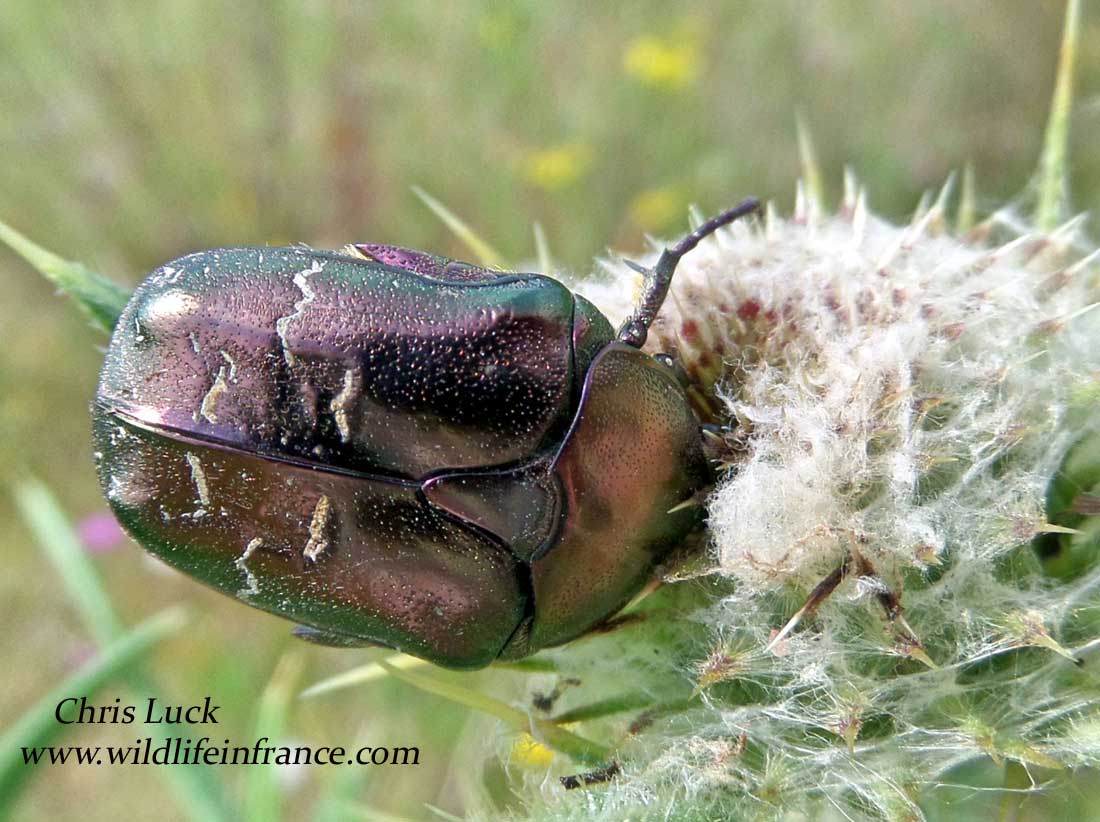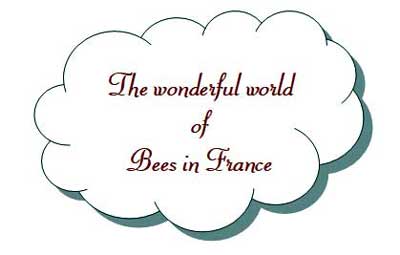Chafers in France
What's a Chafer?
When people talk of Chafers as a rule most people will immediately think of Cockchafers or May bugs as they are known in the UK. However there are a number of beetles referred to as Chafers in English which come from various sub families and genus within the family Scarabaeidae or Scarabs, (240 species in France).
Equally French people will frequently refer to Cockchafers as Le Hanneton but there are also many Hannetons such as Le Hanneton du blée or Le Hanneton des roses and strictly speaking the common name for Cockchafer in French should be Le hanneton commun, (Common Chafer).
They are stout bodied beetles with club shaped antennae.
These huge antennae are Lamellate - the segments towards the end are flattened and plate-like which gives the appearance of a fan when opened. They have short elytra (wing cases) which leave the tip of the abdomen exposed and often have brightly coloured or metallic bodies.
Their larvae depending on species will either eat plant roots, compost, manure, leaf mould or rotting wood.
The adults variously eat pollen, leaves, nectar and flowers.
All are an important food source for other species that include bats, hedgehogs, badgers, owls, nightjars and a huge number of other species
A small selection of the main common species that are easily seen
Blue Chafer beetle
Hoplia coerulea
Hanneton du blée
Hoplia coerulea is a beetle
from the Rutelinae family or Shining leaf chafers. The genus Hoplia is
represented in Europe with 39 species.
They are a small beetle 8 to 10 mm. Males are a striking iridescent azure blue, females are a rather dull brown. The colour of the males can be explained by the microstructure of the approximately 3.5 micrometer thick scales, in which there are approximately 22 parallel layers of chitin, which are coated on the top by small, parallel rods. When water is absorbed, the colour shifts to the emerald green range.
They are only found in South West Europe and hardly north of the Loire in France. Adults can be encountered from May until August in the areas close to various types of watercourse, streams and rivers. Males climb vegetation, bushes, grasses and reeds where they wait motionless for a female who is usually safely hidden on the ground or in the lower vegetation. When she is ready she seeks a male, copulates and heads rapidly for the ground which is where she will lay her eggs. These hatch after about 2 weeks and the larvae feed on roots. This is a species with very limited possibility to expand making it vulnerable to any habitat loss with more and more populations disappearing.
Mediterranean spotted chafer Oxythyrea funesta
Cétoine grise or Le drap mortuaire
Oxythyrea funesta can be seen anywhere in France. They are a species that has been expanding its range with climate change, although they are probably still more abundant in the south. Adults emerge in late spring or early summer and are usually to be seen in flowers where they feed on pollen. Their black body is dotted with small hairs and variable white spots. Following mating the female puts her eggs in the soil which in general tends to be rich in humus, manure or compost. Larvae eat roots and fibrous soil matter and develop from June until August or September when they enter a diapause, (a period of suspended or arrested development), until the following spring when at the end of the cycle, they make an oval hull from the humus materials and their own excrement, change into the adult form and emerge after 3 or 4 weeks.
Summer chafer
Amphimallon
solstitiale Hanneton de la Saint-Jean
Amphimallon solstitiale adults are to be seen during June, July and August often first appearing close to the summer solstice. They are primarily crepuscular or nocturnal and may be observed when swarming around tree tops and shrubs or even buildings occasionally in nuptial flights. After emerging and following a period of feeding on plant and tree foliage the females mate and lay their eggs into the soil where the larvae will feed on the roots of a range of plants, typically herbaceous grasses. They usually develop over 2 years and when fully-grown, in late spring, they measure about 30 mm and are creamy-white with yellowish brown head and appendages. Pupation occurs in a subterranean cell that they make in early June and the developed adults emerge after about 2 weeks. They are a pale sandy brown and considerably smaller than Cockchafers and lack the lateral triangular white abdominal markings and although they are a species that has suffered huge declines they will often be seen in large numbers where present.
Cockchafer
Melolontha melolontha Hanneton commun
Melolontha melolontha. Cock Chafer adults emerge in April / May and live for perhaps 6 weeks although frequently less. During this time they mate and females then bury their eggs about 10 to 20 cm deep in the soil in different places with up to 80 or so in total. What’s important to understand here is that the Cock chafer eggs are usually laid in undisturbed old unmanaged grassland in poor soil. This can lead to problems where they are present when old grassland is initially converted into vegetable beds where they may eat roots. The larvae are polyphagous; they attack the roots of various plants including potatoes, meadow grasses and trees. In fact historically they were a major agricultural pest and following the use of vast quantities of pesticides including DDT and Lindane their numbers have been drastically reduced and are completely absent in many areas. Mercifully these pesticides have been banned now in the EU as have all applications of pesticides that function in the soil and numbers are slowly increasing. The larvae once hatched develop in the soil where they eat roots for 3 to 5 years at which point pupation takes place in the autumn and the adults emerge the following year. There is an almost identical species in France with which they could be confused which is the Forest cockchafer, Melolontha hippocastani, which is a species found in woodlands and we can treat the two species together..
Rose Chafer
Cetonia aurata
Cétoine
dorée or Hanneton des roses
Cetonia aurata. Following emergence and mating in early summer the female Rose Chafers lay their eggs in decaying organic matter and then die shortly after. This is why people find the grubs in their compost heaps and sometimes in plants, shrubs and trees that are either purchased in pots or where they have used high fiber potting compost The larvae spend their lives and develop where the eggs have been deposited which will be in compost, manure, leaf mould, and occasionally well rotted wood where they are the equivalent of earth worms and help break things down so in this respect they are very beneficial. They don’t eat living roots, only decomposed or decomposing vegetative matter. They have a two-year life cycle pupating in June or July of the second year when it’s possible that some adult beetles may emerge in autumn, but normally they emerge the following spring or early summer.

